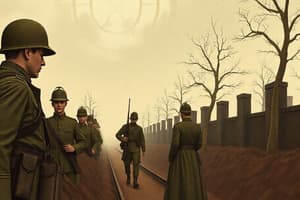Podcast
Questions and Answers
What tactic did the Allies use to stop the German advance at the Marne River?
What tactic did the Allies use to stop the German advance at the Marne River?
- They formed an underwater blockade to restrict supplies.
- They used tanks to break through enemy lines.
- They established an air superiority to bombard German positions.
- They employed taxi cabs to rush troops to the front. (correct)
What was the purpose of the zigzag layout of the trenches?
What was the purpose of the zigzag layout of the trenches?
- To provide a more aesthetic appearance to the landscape.
- To prevent enemy fire from sweeping along the entire length of the trench. (correct)
- To make it easier for supply trains to reach the front lines.
- To allow greater space for resting soldiers in the trenches.
Which disease was NOT typically associated with trench conditions?
Which disease was NOT typically associated with trench conditions?
- Body lice infection
- Malaria (correct)
- Trench mouth
- Trench foot
What psychological impact did trench warfare have on soldiers?
What psychological impact did trench warfare have on soldiers?
What feature was specifically designed to protect the trenches?
What feature was specifically designed to protect the trenches?
Flashcards
No Man's Land
No Man's Land
A zone of land between opposing trenches, characterized by its dangerousness due to the proximity of enemy forces and the presence of obstacles like barbed wire and landmines.
Trench Warfare
Trench Warfare
A deep, narrow ditch dug by soldiers to provide protection from enemy fire and allow for defense.
Shell Shock
Shell Shock
A condition affecting soldiers who were mentally and emotionally traumatized by the horrors of war, leading to physical and psychological problems.
Trench Mouth
Trench Mouth
Signup and view all the flashcards
Digging in
Digging in
Signup and view all the flashcards
Study Notes
Western Front
- Germany wanted to capture Paris before Britain and Russia could fully mobilize.
- Allied forces moved faster than anticipated.
- Allied forces used every available vehicle.
- Allies forced German retreat to the Aisne River.
- October 1914 saw both sides fortifying defensive positions.
Trench Warfare
- Deep trenches were dug and protected by machine guns and barbed wire.
- Trenches extended hundreds of kilometers.
- Trenches extended to borders of Switzerland.
- Parallel trenches were separated by a 25-meter corridor known as "No Man's Land."
- "No Man's Land" contained buried land mines.
- Trenches were zig-zagged to obstruct enemy fire.
- Trenches provided communication trenches.
- Trenches housed command, and reserve units.
- Wet conditions made trenches extremely muddy, and difficult to navigate.
Trench Conditions
- Trench foot, infection, disease, and other health problems plagued soldiers.
- Rats and disease carried by lice thrived
- in the mud.
- Constant exposure to cold, moisture, and unsanitary conditions resulted in widespread sickness.
- Rotting of flesh was prevalent.
- Soldiers experienced stress and psychological damage due to trauma.
- Soldiers experienced shell shock (PTSD).
Canadian Troops
- In mid-April 1915, 20,000 Canadian troops took positions alongside other Allied forces.
Studying That Suits You
Use AI to generate personalized quizzes and flashcards to suit your learning preferences.




